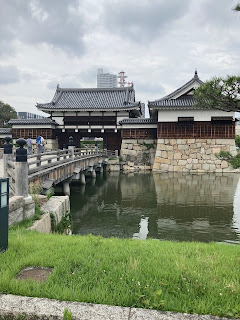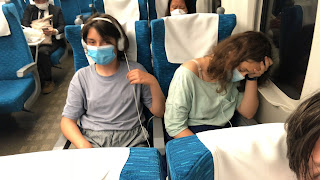A good breakfast opens the day, suitcases have to be made, and off we go. First stop, the station. We find the coin locker, check as much as we can in one locker, and walk back towards Hiroshima Castle. The castle wooden parts were completely destroyed (and that was the majority), only some stones remained, but suffered and were displaced. Parts of the castle have been rebuilt, however. But our true objectives are the three trees that survived the bomb. Called Hibakujumoku ( 被爆樹木) in Japanese, and sometimes survivor trees, they stand clearly in the garden of the castle. There is a eucalyptus and a willow who were approximately at 750m from the epicenter, and a holly that was approximately at 950m. It is impressive to think they managed to survive.
After this, we buy onigiris and eat them before going to see the A-bomb dome in daylight. The bomb exploded 600m above ground, about 100m south of the dome. We tour the peace parc, look at the memorial for the children workers that died on the site (many kids 12-18 were enlisted to work and were on the site). We reach the children peace monument. This memorial was requested by school children and teachers who lost a classmate to cancer a while after the war. We made a stop to look through the cenotaph and see the permanent flame, then enter the Hiroshima peace museum. The place is impressive, and it is with heavy hearts that we walk through it. Some photos are harsh to look at, and some preserved objects are also tough to stomach. Pieces of cloth, a stone step that has the mark of the person that was sitting on it and died there, a glass coke bottle that melt, pieces of metal completely bent, a child tricycle… But the stories behind all of these are, of course, what makes this museum relevant. Next we head to the very beautiful memorial to the victims, before rushing to the station. On the way we passed the memorial for the Korean victims as well as the clock that chimes every day at 8:15am. Gadea and Eyquem go pick up what we left in the coin locker, while Noe and Samuel line up to try to get seat reservations. All Shinkanzens come with a few cars that do not require reservations, but we would prefer to be sure to have seats. The guy is efficient and off we go to board the train. We thankfully have 10 minutes to change in Kobe, which allows us to buy Bento boxes. Arriving in Tokyo station, we hunt for stamps, and for the special Eki stamp notebook, then head home.











Leave a Reply